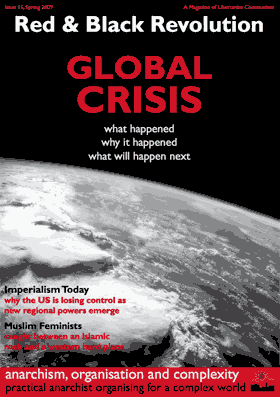Over 30 years of anarchist writing from Ireland listed under hundreds of topics
WSM’s Organisational Structures
This article from Red & Black Revolution 15 describes and explains the internal organizational structure of the WSM as it was in 2008. See the WSM Constitution to get an idea of any changes that may have been made since. This article was originally a box in the article Practical Anarchist Organising.
National Conference
The National Conference is the WSM’s supreme decision making forum. It takes place twice a year (Spring & Autumn) and is open to all members. Any member can put a motion to conference for consideration and motions are decided by majority vote. In addition to setting policy, the National Conference elects officers and hosts strategic discussions.
Delegate Council
Delegate Council meets once a month. Each branch is represented by two delegates, who can carry votes from their branches. Delegate Council serves to set policy in between conferences and to coordinate between the branches. The council is hosted in turn by each of the WSM branches, meaning that its location rotates between Dublin, Cork and Belfast.
Interim Decisions Committee
The sole role of the Interim Decisions Committee is to make emergency deci- sions in situations where it is imperative that a decision be reached before a Delegate Council can convene and before all of the organisation’s branches next meet. It consists of three members, the national secretary and two others elected by National Conference.
Branches
All members belong to a WSM branch which meets regularly (weekly or fortnightly), to discuss political matters and to organise the work of the organisation.
The Benefits of Growth & Structure
The development and maintenance of the WSM’s decision making structure has required a considerable investment of the organisation’s resources. This cost, however, is offset by the considerable gains in terms of practical organising capacity. Not only has the organisation grown, but it has managed to maintain an ability to act in a coherent way. This means that the WSM can get involved in more campaigns and more political and social struggles, It also means that the organisation can organise more ambitious events whose promotion and running require significant numbers of people to coordinate their work.

This article was first published in
Red & Black Revolution 15, Spring 2009
[Download the PDF]

